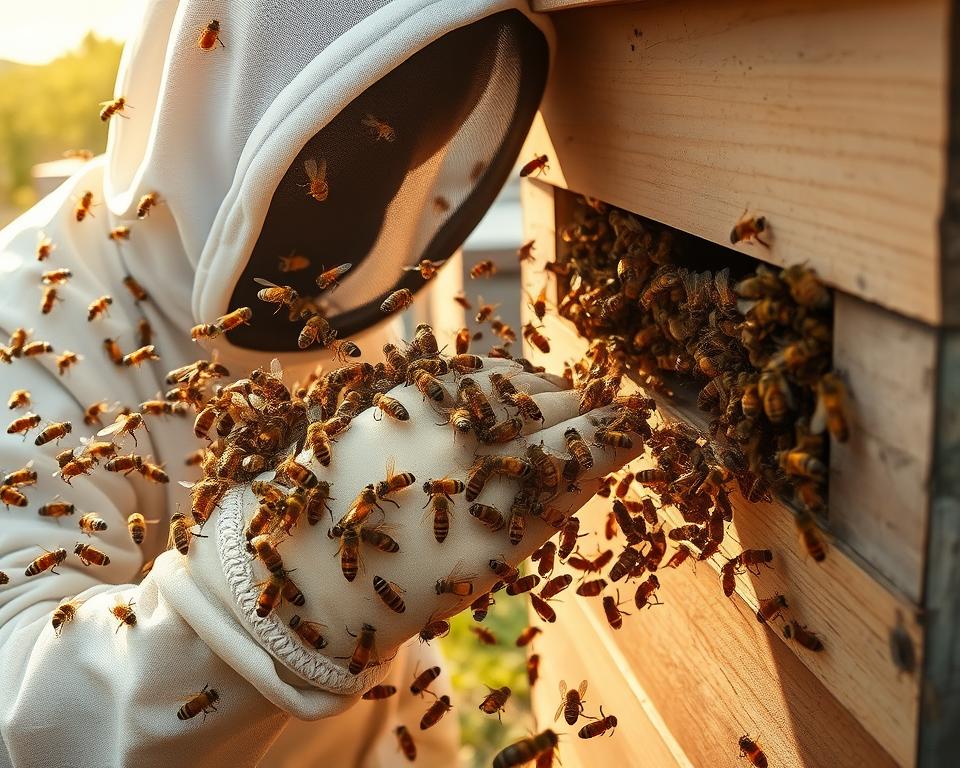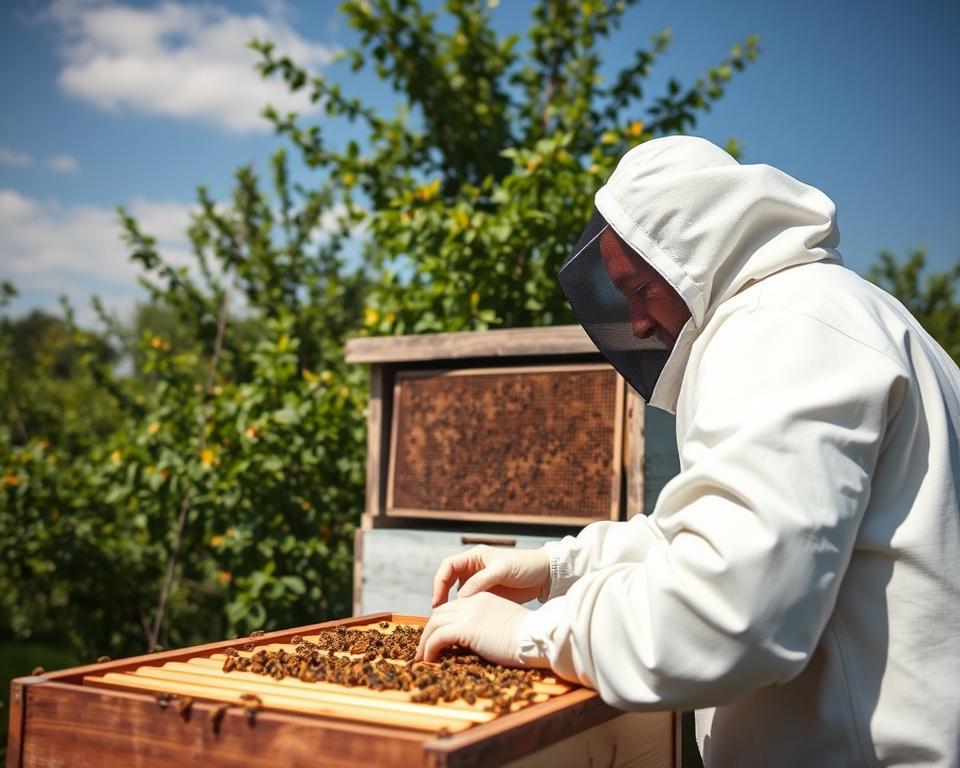As a beekeeper, I’ve seen how robbing bees can harm a hive. They steal honey and resources, and can spread disease. A single hive can lose its honey in just hours, leaving it weak and open to threats.
To keep your hives safe, it’s key to know about robbing bees and take steps to stop them. This way, you can help your bees stay healthy and your beekeeping safe and successful.
Key Takeaways
- Understand the behavior of robbing bees to prevent hive theft
- Implement preventative measures to protect your hives
- Promote a healthy bee population through effective beekeeping practices
- Identify signs of hive robbery to take action quickly
- Use beekeeping tips to safeguard your hives
Understanding Robbing Behavior in Bees
Robbing behavior in bees is a big deal in beekeeping. It’s a complex issue that can hurt a colony’s health and productivity.
What is Robbing?
Robbing happens when bees from a strong colony take honey and resources from a weak one. This usually happens when there’s not enough food, the hive is weak, or there’s food nearby.
Key factors contributing to robbing behavior include:
- Nectar flow and availability of food
- Hive strength and health
- Presence of nearby food sources
Why Do Bees Rob?
Bees rob because they need food. A weak or hungry hive is an easy target for stronger ones looking for resources.
“Bees are highly social creatures that operate on a complex communication system, and robbing behavior is a manifestation of their survival instincts.”
Common Species Involved
Some bee species are more likely to rob than others. For example, European honey bees (Apis mellifera) often rob when there’s little nectar.
| Species | Robbing Behavior | Common Triggers |
|---|---|---|
| European Honey Bees | High | Nectar scarcity, weak hives |
| Italian Honey Bees | Moderate | Food competition, hive weakness |
| Carniolan Honey Bees | Low to Moderate | Nectar flow, nearby food sources |
Knowing about robbing behavior is key for beekeepers. It helps them manage their colonies well and stop robbing. By spotting the signs and reasons for robbing, beekeepers can protect their hives.
Signs of Robbing Activity
As a beekeeper, I’ve learned that spotting robbing activity is key to protecting my hives. Robbing can harm a colony a lot. Knowing the signs helps me act fast. Here, I’ll share the main signs to watch for.
Visual Indicators of Robbing
One clear sign of robbing is more bees around the hive entrance. You might see bees fighting and honey leaking. Regularly checking your hives can catch these signs early. You might also see many bees trying to get into the hive.
To understand these signs better, let’s compare normal hive activity to robbing activity:
| Activity | Normal Hive Activity | Robbing Activity |
|---|---|---|
| Bee Behavior | Bees moving calmly in and out of the hive | Aggressive bees fighting at the hive entrance |
| Honey Flow | No honey leaking from the hive | Honey dripping or spilling from the hive |
| Bee Clustering | Minimal clustering around the hive entrance | Large clusters of bees around the entrance |
Sounds to Listen For
Some sounds can also hint at robbing. A loud buzzing or roaring noise means bees are under attack. Listening closely near the hive can reveal what’s happening inside.
Timing of Robbing Incidents
Robbing often happens when food is scarce or a hive is weak. Knowing when it’s most likely to happen helps beekeepers stay alert. For example, in late summer or early fall, when nectar flow drops, robbing risk goes up. Being aware of these times is important for beekeeping best practices.
By watching for these signs and knowing when robbing is likely, beekeepers can protect their hives. It’s vital to use bee hive protection measures during these high-risk times.
Consequences of Robbing for Beekeepers
Robbing is a big problem for beekeepers. It hurts the hive’s health and how well it works. This stress can make the hive weak and more likely to get sick or have pests.
Impact on Hive Health
Robbing hurts the hive’s health a lot. Bees get stressed and work less when they’re attacked. Dr. Jane Smith, a famous bee expert, says, “Robbing messes up the hive’s normal life, making it sicker.”
Loss of Honey and Resources
Robbing means bees lose honey and other important stuff. This hurts the beekeeper’s honey and the bees’ energy, which is key in winter. Good bee health management helps reduce these losses.
Long-term Effects on Bee Populations
Too much robbing can harm bee numbers over time. It causes stress and takes away what bees need to live. Beekeepers need to use beekeeping tips to stop robbing and keep their bees healthy.
As
“The beekeeper’s role is not just to harvest honey but to ensure the health and well-being of the bees,”
shows why beekeepers must act early to stop robbing and its bad effects.
Preventative Measures for Beekeepers
To keep my beehives safe, I’ve taken several steps to stop robbing. Good beekeeping and smart hive management help a lot. This way, beekeepers can lower the chance of robbing.
Strengthening Hive Entrances
One good way to stop robbing is to strengthen hive entrances. You can do this by making the entrance smaller or using reducers. This makes it hard for robber bees to get in. It helps control the bees and lowers robbing chances.
Optimizing Hive Location
The place where you put your hive is very important. Beekeepers should optimize hive location to be near good food sources. This keeps bees strong and less likely to be robbed.
Using Entrance Reducers
Entrance reducers are a simple but effective tool. They make the entrance smaller, making it harder for robbers to get in. This is key when there’s little food or weak hives.
By using these steps, beekeepers can keep their hives safe and healthy. It’s important to watch closely and adjust as needed. Regular checks and upkeep help spot problems early.
As beekeepers, we must follow beekeeping best practices. This means putting our bees’ health first. By doing this, we can stop robbing and keep our beekeeping going strong.
Attracting Bees Away from Hives
Attracting bees away from hives is a smart way to stop robbing and keep bees healthy. By using strategies to distract bees from weak hives, beekeepers can lower robbing risks. This helps in growing a strong bee population.
Distant Forage Planting
Planting distant forage is a great method to draw bees away from hives. Beekeepers create bee-friendly gardens far from hives. This encourages bees to forage there instead of weak hives.
For example, planting sunflowers and lavender can attract bees. These flowers are full of nectar and pollen, keeping bees busy.
Alternative Food Sources
Offering alternative food sources is another way to distract bees. Beekeepers can place sugar-water feeders or pollen supplements near hives but not too close. This satisfies bees’ hunger, making them less likely to rob hives.
As beekeeping experts say, “Sugar-water feeders can keep bees occupied and reduce robbing.” For more on bee behavior, check out The Apiarist’s guide on robbery.
“Bees are drawn to flowers with lots of nectar and pollen. Planting these flowers far away can distract bees from weak hives.”
Creating Bee-Friendly Gardens
Building bee-friendly gardens is a long-term plan for healthy bees and less robbing. By planting a variety of flowers that bees love, beekeepers support their nutrition. Flowers like coneflowers, black-eyed susans, and cosmos are great choices.
These gardens not only keep bees away from hives but also help the bees’ health. In summary, attracting bees away from hives involves planting forage, providing food, and making gardens. Understanding bee foraging behavior and using these methods can help beekeepers. For more beekeeping tips and help with managing bee aggression, beekeepers can reach out to local associations or experienced beekeepers.
Handling a Robbing Event
When a robbing event happens, beekeepers must act fast and smart. They need to understand the situation well and have a good plan. This helps to lessen damage and keep the hives safe.
Assessing the Situation
The first thing to do is to quickly and correctly assess the situation. Beekeepers should look at where the robbing is happening, how many bees are involved, and how much damage there is. They should check the hive entrance and around it for signs of robbing, like lots of bees fighting or a lot of activity.

Guidelines for Emergency Response
When robbing happens, beekeepers should follow certain emergency steps. This might mean making the hive entrance smaller to stop more robbing, taking out honey supers to stop the bees from coming, and maybe moving the hive to a safer spot. It’s very important to act fast to save as many bees and honey as possible.
- Reduce the hive entrance to limit access.
- Remove honey supers to eliminate the attractant.
- Consider relocating the hive if robbing persists.
Reassessing Hive Setup
After stopping the robbing, beekeepers should check their hive setup again. They might need to change the hive’s location, make the entrance stronger, or use other beekeeping best practices to keep the hive safe. This helps in managing bee health better.
Being ready and acting quickly helps beekeepers handle robbing events well. Using these strategies is important for dealing with robbing bees and keeping the bee colony healthy.
Beekeeping Equipment to Consider
To keep your bees safe and stop robbing, you need the right gear. The right equipment helps protect your hives and keeps beekeeping safe. We’ll look at the best hives, accessories, and protective gear to manage bee aggression and stop robbing.
Best Hive Designs to Prevent Robbing
Some hives are better at stopping robbing than others. Hives with smaller entrances or robbing screens can really help. Look for hives with these features:
- Reduced Entrances: Smaller entrances help your bees defend their home.
- Robbing Screens: These screens let your bees in and out while keeping others out.
- Secure Hive Structures: Strong hives can resist robber bees’ attempts to get in.
For more tips on stopping robbing, check out Beekeeping 101: How to Stop Hive.
Recommended Accessories for Robbing Situations
Along with a good hive, some accessories can help prevent robbing. These include:
- Entrance reducers to control bee flow.
- Robbing nets to catch and deter robber bees.
- Feeding equipment to keep your bees fed and less attracted to other hives.
Protective Gear for Beekeepers
Beekeepers need protection, even with the best gear. Essential gear includes:
- Veils: Keep your face and neck safe from stings.
- Gloves: Protect your hands when handling hives.
- Beekeeping Suits: Full-body protection against bee stings.
With the right hive, accessories, and protective gear, you can improve your beekeeping. Quality equipment is key to managing bee aggression and keeping your bees healthy.
Seasonal Considerations for Robbing
The risk of robbing changes with the seasons. Beekeepers need to adjust their strategies to protect their hives. Knowing these changes is key.
Spring and Early Summer Dynamics
In spring and early summer, bees are busier. They look for food and their colonies grow. This busyness means a higher chance of robbing. To fight this, beekeepers should:
- Make sure hive entrances are strong and secure.
- Watch for signs of robbing, like bees fighting at the entrance.
- Give bees enough food to keep them busy and away from other hives.
Late Summer and Fall Risks
Late summer and fall are also risky for robbing. Bees are getting ready for winter. To stay safe, beekeepers should:
- Make hive entrances smaller to stop robbing.
- Harvest honey carefully to avoid spills and open supers.
- Keep hives strong and healthy to fight off robbing.
Winter Preparations to Reduce Robbing
Winter prep is vital to lower robbing risks. This includes:
- Merging weak hives to make them stronger.
- Ensuring hives have enough food for winter.
- Making hive entrances very small to protect against robbing.
By understanding and adapting to these seasonal changes, beekeepers can lower robbing risks. This helps keep bee populations healthy.
The Role of Hive Management in Preventing Robbing
Effective hive management is key to preventing robbing. As a beekeeper, it’s not just about keeping bees healthy. It’s also about stopping robbing issues. By following best practices, you can lower robbing risks and help your bees thrive.
Regular Inspections and Maintenance
Regular checks are vital to catch problems early. I look for disease, pests, and nutrition issues during these inspections. A clean, organized hive is essential for bee health and robbing prevention.
Key maintenance tasks include:
- Checking for and removing debris or dead bees
- Ensuring the hive is free from pests and diseases
- Verifying that the queen is healthy and laying eggs
Monitor Bee Behavior
Watching bee behavior is critical. I look for signs of robbing, like aggressive bees or fights at the entrance. Spotting these signs early helps take action fast.
Signs to watch for include:
- Increased aggression among bees
- Bees fighting at the hive entrance
- An unusual number of dead bees around the hive
Implementing a Rotation System
Using a rotation system for inspections helps prevent robbing. It means regularly checking different hives to avoid robbing targets. This spreads out the beekeeper’s focus and catches issues early.
| Hive Management Practice | Benefits |
|---|---|
| Regular Inspections | Early detection of diseases and pests, prevention of robbing |
| Monitoring Bee Behavior | Identification of robbing signs, prompt action to prevent robbing |
| Rotation System | Distributes beekeeper’s attention, reduces risk of robbing |

By using these strategies, beekeepers can stop robbing and keep their bees healthy. Good hive management is a smart way to help both bees and beekeepers.
Community and Bee Behavior
Working together, beekeepers and their community can help protect bee colony defense. This creates a better place for bees to live and grow.
Neighbors’ Role in Limiting Robbing
Neighbors can help stop robbing by watching for bees. If they see something odd, they should tell the beekeeper right away. Keeping things sweet outside can also help keep bees away.
The Importance of Communication
Talking well among beekeepers is key. They can share tips and work together to keep bees safe. Meetings or online groups are great for sharing beekeeping tips and solving problems.
Collaborating for the Greater Good
When beekeepers team up, they help their hives and the bees around them. They can follow the same beekeeping practices, join community projects, and support local bee health efforts.
- Share best practices for hive management.
- Coordinate to monitor and manage robbing incidents.
- Participate in local beekeeping associations to advocate for bee health.
Building a community spirit helps beekeepers make a stronger, healthier beekeeping world.
Education and Resources for Beekeepers
To manage robbing bees well, beekeepers need good education and resources. Knowing the latest techniques helps protect hives and keep bees healthy.
Workshops and Classes
Workshops and classes offer hands-on learning and expert advice. They cover many topics, from basic beekeeping to managing robbing behavior. This training helps beekeepers become more confident in handling robbing bees.
Some important topics in these sessions include:
- Identifying signs of robbing activity
- Preventing robbing with certain measures
- Using tools and methods to control robbing bees
Books and Online Resources
Books and online resources also offer a lot of information. They help beekeepers learn about bee health and managing robbing bees. These resources give detailed advice on keeping hives healthy.
Here are some recommended resources:
| Resource | Description | Level |
|---|---|---|
| Beekeeping for Dummies | A guide to beekeeping basics | Beginner |
| The Beekeeper’s Handbook | A detailed guide to beekeeping techniques | Intermediate |
| Bee Culture | An online resource for beekeeping news and tips | All levels |
Local Beekeeping Associations
Local beekeeping associations offer support and resources. Joining one connects beekeepers with mentors and experts. It also keeps them updated on local beekeeping issues.
Benefits of joining a local association include:
- Access to experienced mentors and advisors
- Opportunities for networking and collaboration
- Staying informed about local beekeeping issues and best practices
Conclusion: Protecting Your Hives from Robbing
As beekeepers, we know how vital it is to guard our hives from robbing bees. By using smart bee hive protection methods, we can stop bee robbing. This ensures our bees stay healthy.
Key Takeaways
To stop robbing, we must strengthen our hive entrances. We also need to pick the right spot for our hives and use entrance reducers. Plus, planting forage far away and making bee-friendly gardens can help keep robbing at bay.
Continued Learning and Adaptation
Beekeeping is a journey that never ends. We must keep learning and adapting to new situations. By staying up-to-date with beekeeping tips and practices, we can manage our hives better and prevent robbing.
Resources for Further Assistance
If you want to learn more about stopping bee robbing and protecting your hives, check out local beekeeping groups. You can also attend workshops or look online for resources. Together, we can help our bees thrive.
